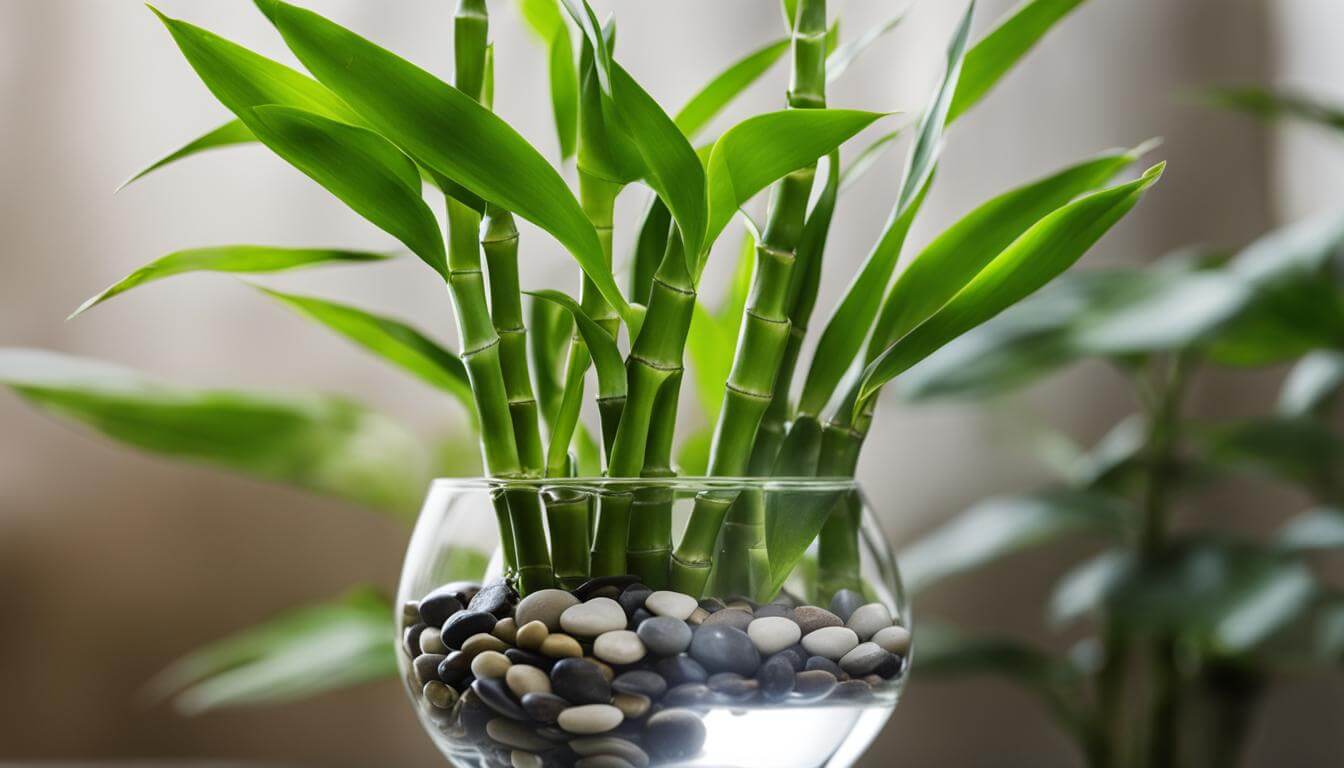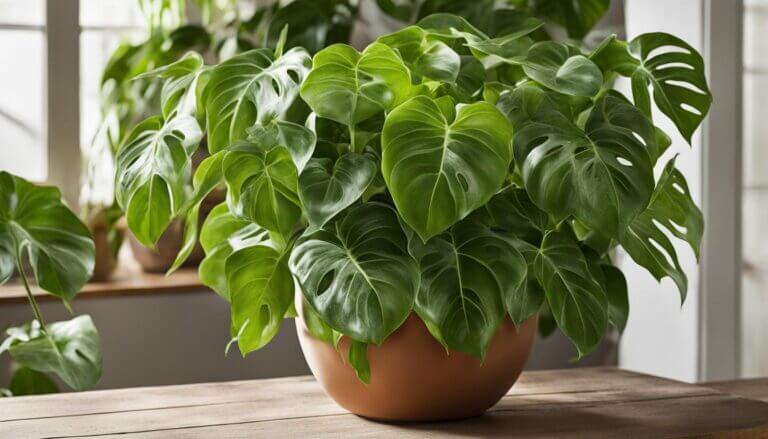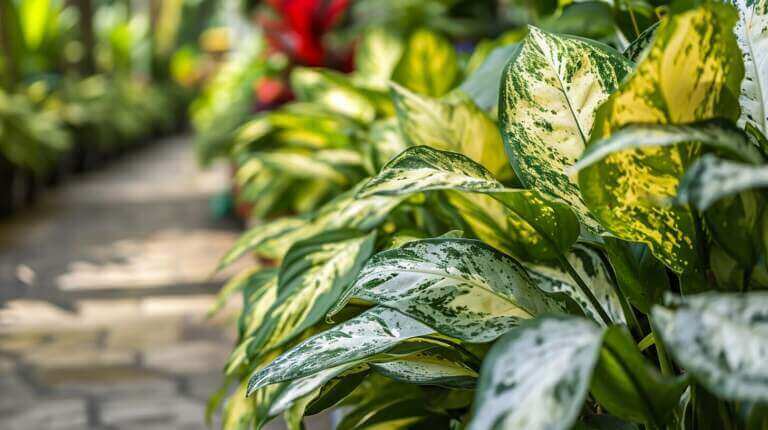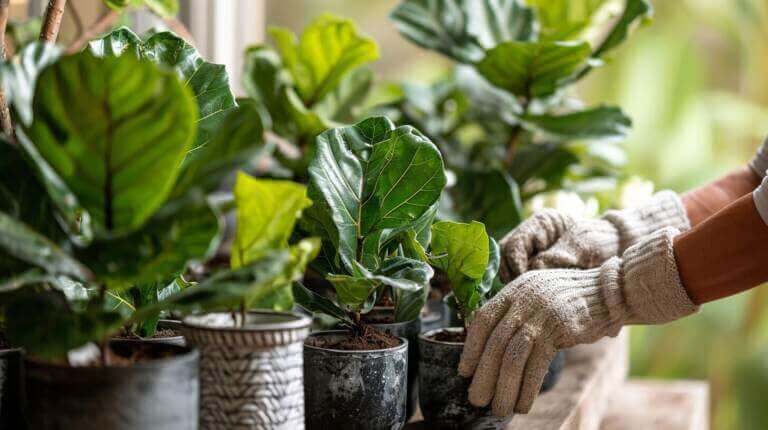Decorative plants can bring beauty and fresh air into our homes, but it’s important to be aware of any potential risks they may pose to our beloved pets. Lucky Bamboo, a popular choice for indoor plants, can actually be toxic to cats and dogs. It’s crucial to understand the dangers and take necessary precautions to keep our furry friends safe.
Lucky Bamboo contains substances that are poisonous to cats and can cause a range of symptoms if ingested. These symptoms may include drooling, diarrhea, increased heart rate, and loss of coordination. The effects of poisoning can appear within 6 to 12 hours after ingestion. If you notice any of these symptoms in your pet, it’s essential to seek immediate veterinary care. Early detection and treatment play a crucial role in your pet’s recovery from Lucky Bamboo poisoning.
Key Takeaways:
- Lucky Bamboo is toxic to cats and dogs, causing symptoms such as drooling, diarrhea, and increased heart rate.
- If your pet shows signs of Lucky Bamboo poisoning, seek veterinary care immediately.
- Prevent poisoning by keeping Lucky Bamboo out of your pet’s reach and providing cat-friendly alternatives.
- Safe alternatives to Lucky Bamboo include clumping bamboo species, real Bamboo, Button Fern, and African Violets.
- If you suspect your pet has ingested a toxic plant, contact your vet for advice and potential veterinary care.
Symptoms and Risks of Lucky Bamboo Plant Poisoning in Cats
If a cat ingests Lucky Bamboo, they may experience a range of symptoms. These can include vomiting, diarrhea, excessive drooling, and loss of appetite. In more severe cases, the cat’s pupils may become dilated, and they may show signs of dehydration. It’s important to contact a veterinarian or a poison control center immediately if you suspect that your cat has ingested Lucky Bamboo. Prompt treatment can help alleviate the symptoms and prevent further complications.
In some instances, cats may be curious and nibble on the leaves or stems of the Lucky Bamboo plant. This can lead to gastrointestinal distress, causing vomiting and diarrhea. Excessive drooling may also occur as a result of the plant’s toxic properties. Loss of appetite is another possible symptom, indicating that the cat is feeling unwell after ingesting the plant.
Risks of Lucky Bamboo Plant Poisoning
The ingestion of Lucky Bamboo can be toxic to cats, causing various adverse effects on their health. The plant contains certain compounds that are harmful to cats’ digestive systems. When ingested, these compounds can cause gastrointestinal upset, including vomiting and diarrhea. Additionally, the plant’s toxic properties can lead to dehydration due to increased fluid loss from vomiting and diarrhea.
Dilated pupils can also be a sign of Lucky Bamboo poisoning in cats. The toxic substances within the plant can affect the cat’s nervous system, leading to dilation of the pupils. This, along with other symptoms, should be taken seriously and prompt veterinary care should be sought to ensure the well-being of the cat.
| Symptoms of Lucky Bamboo Plant Poisoning in Cats | Actions to Take |
|---|---|
| Vomiting | Immediately contact a veterinarian or poison control center |
| Diarrhea | Seek veterinary care for further evaluation and treatment |
| Excessive drooling | Monitor the cat’s condition and consult a veterinarian if symptoms persist or worsen |
| Loss of appetite | Observe the cat’s eating habits and consult a veterinarian if they refuse food for an extended period |
| Dilated pupils | Contact a veterinarian immediately for proper assessment and treatment |
Preventing Lucky Bamboo Plant Poisoning in Pets
To ensure the safety of your pets, it is crucial to take steps in preventing Lucky Bamboo plant poisoning. Lucky Bamboo is an indoor plant that is commonly used as a decorative element in homes. While it is generally considered a low-maintenance plant, it is important to be aware that certain parts of the plant may be toxic to cats and other pets.
To start, it is best to keep your Lucky Bamboo plant out of reach of your pets. Place the plant in an area where they cannot access it, such as on a high shelf or in a room that is off-limits to them. If you have a curious and agile cat that likes to explore, consider hanging the plant in a decorative basket to prevent them from nibbling on it.
In addition to keeping the plant out of reach, it is also important to provide alternative options for your pets to satisfy their natural chewing instincts. Consider introducing cat-friendly plants that are safe for them to nibble on, such as catnip or wheatgrass. These plants not only provide a safe alternative for your pets but can also add a touch of greenery to your home.
It is worth noting that while Lucky Bamboo is toxic to cats, there are other plants with similar names that pose a risk as well. Heavenly Bamboo (Nandina domestica), despite its name, is also toxic to cats and dogs. Therefore, if you are considering adding a new plant to your home, it is important to research its toxicity before making a purchase.
Table: Toxic Plants to Avoid for Pets
| Plant | Toxicity Level | Pets Affected |
|---|---|---|
| Lucky Bamboo (Dracaena sanderiana) | High | Cats, Dogs |
| Heavenly Bamboo (Nandina domestica) | Moderate | Cats, Dogs |
| Oleander (Nerium oleander) | High | Cats, Dogs, Horses |
| Sago Palm (Cycas revoluta) | High | Cats, Dogs |
By taking these precautions and being mindful of the plants you introduce into your home, you can help protect your pets from the risks of Lucky Bamboo plant poisoning and other toxic plants.
Safe Alternatives to Lucky Bamboo for Pet-friendly Homes
If you’re a pet owner, it’s important to prioritize the safety of your furry friends. While the allure of Lucky Bamboo may be tempting, it’s better to be safe than sorry when it comes to choosing plants for your home. Luckily, there are plenty of safe alternatives to consider.
When searching for pet-friendly plants, opt for species that are known to be safe. Clumping bamboo varieties, such as Bambusa and Fargesia, are generally considered non-toxic to cats and dogs. These plants make for a beautiful addition to your home while keeping your pets safe from harm.
There are also other common plants that are safe for your feline friends. Real Bamboo, Button Fern, Blue Echeveria, Christmas Cactus, Golden Palms, African Violets, Potted Mini-Roses, and Chinese Money Plant are all great choices that won’t pose a risk to your cat’s health.
If your cat decides to nibble on a plant and is showing any symptoms of distress, it’s important to take action immediately. Call your vet for guidance and seek veterinary care if necessary. Remember, prevention is key, so always keep potentially toxic plants out of reach and provide your pets with safe alternatives to satisfy their curiosity.
FAQ
Is Lucky Bamboo toxic to cats and dogs?
Yes, Lucky Bamboo is toxic to cats and dogs. The entire plant is toxic to cats and can cause symptoms such as drooling, diarrhea, increased heart rate, and loss of coordination.
What should I do if my pet ingests Lucky Bamboo?
If your pet ingests Lucky Bamboo, it is important to seek veterinary care immediately. Early detection and treatment are key to helping your pet recover from Lucky Bamboo poisoning. Symptoms may appear 6 to 12 hours after ingestion.
What are the symptoms of Lucky Bamboo poisoning in cats?
Cats that ingest Lucky Bamboo may experience symptoms such as vomiting, diarrhea, excessive drooling, and loss of appetite. In severe cases, their pupils may become dilated, and they may show signs of dehydration.
How can I prevent Lucky Bamboo plant poisoning in my pets?
To prevent Lucky Bamboo plant poisoning in pets, it is important to keep the plant out of their reach. Place the plant in an area where they cannot access it or consider hanging it in a decorative basket. Use deterrents such as garlic paste or chili powder to keep cats away from the plant. Provide cat-friendly plants as an alternative for them to nibble on. Avoid planting heavenly bamboo, as it is also toxic to cats.
Are there safe alternatives to Lucky Bamboo for pet-friendly homes?
Yes, there are several safe alternatives to Lucky Bamboo for pet-friendly homes. Clumping bamboo species like Bambusa and Fargesia are generally considered safe. Other cat-friendly houseplants include real Bamboo, Button Fern, Blue Echeveria, Christmas Cactus, Golden Palms, African Violets, Potted Mini-Roses, and Chinese Money Plant. These plants are non-toxic to cats and can add beauty to your home without posing a risk to your furry friends. If you suspect that your pet has ingested a toxic plant, contact your vet for advice and seek veterinary care if necessary.







